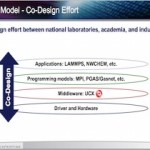In this video, Jeff Kuehn from LANL, Pavel Shamis from ARM, and Gilad Shainer from Mellanox describe progress on the new UCF consortium, a collaboration between industry, laboratories, and academia to create an open-source production grade communication framework for data centric and high-performance applications.
Co-Design Architecture: Emergence of New Co-Processors
“High performance computing has begun scaling beyond Petaflop performance towards the Exaflop mark. One of the major concerns throughout the development toward such performance capability is scalability – at the component level, system level, middleware and the application level. A Co-Design approach between the development of the software libraries and the underlying hardware can help to overcome those scalability issues and to enable a more efficient design approach towards the Exascale goal.”
UCX: An Open Source Framework for HPC Network APIs and Beyond
“Unified Communication X (UCX) is a set of network APIs and their implementations for high performance computing. UCX comes from the combined efforts of national laboratories, industry, and academia to co-design and implement a high-performing and highly scalable communication APIs for next generation applications and systems. UCX solves the problem of moving data memory location “A” to memory location “B” considering across multiple type of memories (DRAM, accelerator memories, etc.) and multiple transports (e.g. InfiniBand, uGNI, Shared Memory, CUDA, etc. ), while minimizing latency, and maximizing bandwidth and message rate.”
Paving the Road to Exascale with Co-Design Architecture
In this special guest feature from the Print’n Fly Guide to SC15 in Austin, Scot Schultz from Mellanox writes that a new era of Co-Design will pave the way to Exascale. “Exascale computing will undoubtedly include three primary concepts: heterogeneous systems, direct communication through a more sophisticated intelligent network, and backward/forward compatibility. Co-Design includes these concepts in order to create an evolutionary architectural approach that will enable Exascale-class systems.”
UCX: Co-Design Architecture For Next Generation HPC Systems
“The UCX Unified Communication X project is a collaboration between industry, laboratories, and academia to create an open-source production grade communication framework for data centric and high-performance applications. At the core of the UCX project are the combined features, ideas, and concepts of industry leading technologies including MXM, PAMI and UCCS. Mellanox Technologies has contributed their MXM technology, which provides enhancements to parallel communication.”
Advancing HPC with Collaboration & Co-design
In this special guest feature from Scientific Computing World, Tom Wilkie reports on two US initiatives for future supercomputers, announced at the ISC in Frankfurt in July.
New UCX Network Communication Framework for Next-Gen Programming Models
UCX is a collaboration between industry, laboratories, and academia to create an open-source production grade communication framework for HPC applications. “The path to Exascale, in addition to many other challenges, requires programming models where communications and computations unfold together, collaborating instead of competing for the underlying resources. In such an environment, providing holistic access to the hardware is a major component of any programming model or communication library. With UCX, we have the opportunity to provide not only a vehicle for production quality software, but also a low-level research infrastructure for more flexible and portable support for the Exascale-ready programming models.”
Slidecast: UCX – Unified Communication X Framework
In this slidecast, Pavel Shamis from ORNL and Gilad Shainer from Mellanox announce the UCX Unified Communication X Framework. “UCX is a collaboration between industry, laboratories, and academia to create an open-source production grade communication framework for data centric and HPC applications.”








